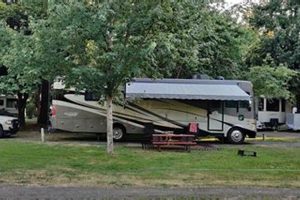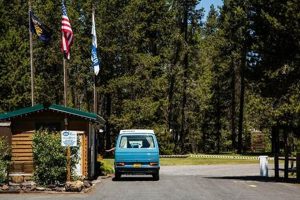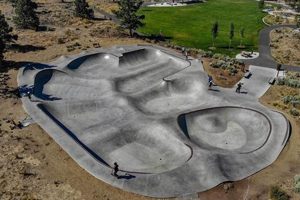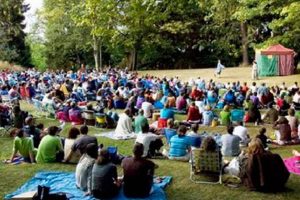A protected recreational area in northeastern Oregon, this destination provides visitors with opportunities to experience the natural beauty and historical significance of the region. Located near the summit of the Blue Mountains, it offers a variety of outdoor activities and a glimpse into the area’s past as a stop along the Oregon Trail. Its designation as a state park ensures the preservation of its resources for public enjoyment.
The site’s importance stems from its role as a crucial watering and resting point for emigrants traveling westward in the 19th century. The presence of natural springs made it an invaluable resource for those undertaking the arduous journey. Today, visitors benefit from recreational opportunities such as camping, hiking, and picnicking, while also gaining an understanding of the challenges faced by pioneers. The park serves as a reminder of the area’s rich history and its significance in westward expansion.
Features of the park include well-maintained campgrounds, interpretive displays that detail the area’s history, and access to hiking trails that traverse the surrounding landscape. The park’s location also provides opportunities for scenic views and wildlife observation, adding to its appeal as a destination for outdoor enthusiasts. Further exploration reveals the multifaceted attractions offered.
Essential Guidance for Visitors
To ensure a safe and enjoyable experience, consider these points before visiting the Oregon State Park.
Tip 1: Plan Ahead: Reservation of campsites is highly recommended, particularly during peak season. Booking in advance secures accommodations and avoids potential disappointment upon arrival.
Tip 2: Prepare for Varying Weather Conditions: The park’s high-altitude location results in fluctuating weather patterns. Pack layers of clothing to accommodate changes in temperature and potential precipitation.
Tip 3: Respect the Environment: Adhere to Leave No Trace principles. Dispose of waste properly, stay on marked trails, and avoid disturbing vegetation or wildlife.
Tip 4: Be Aware of Wildlife: The park is home to various animals. Store food securely to prevent attracting wildlife to campsites and maintain a safe distance from animals encountered.
Tip 5: Stay Informed: Check official park websites or contact park authorities for the latest information on trail closures, fire restrictions, and any other relevant advisories.
Tip 6: Utilize Available Resources: Take advantage of interpretive displays and visitor information centers to learn about the park’s history, ecology, and recreational opportunities.
Tip 7: Hydration is Key: Especially during hiking, ensure sufficient water intake, given the altitude and potential for exertion.
Following these suggestions will contribute to a more fulfilling and responsible visit, ensuring preservation of the park’s resources for future generations.
These preparations enhance the experience and safety of visiting the area.
1. Historic Oregon Trail Stop
The designation as a Historic Oregon Trail stop is intrinsically linked to the identity and significance of Emigrant Springs State Park. This connection underscores the park’s role as a tangible reminder of the arduous journey undertaken by pioneers during westward expansion. The park serves as a preservation site for this important historical intersection.
- Water Source and Resupply Point
The natural springs within the park provided a vital source of water for emigrants and their livestock, crucial for survival on the long journey. The park also served as a location to replenish supplies, offering a respite before continuing westward. This access to resources was fundamental to the success of many wagon trains.
- Rest and Recuperation
The park offered a much-needed place for travelers to rest and recuperate from the hardships of the trail. The availability of water and the relatively sheltered location allowed emigrants to regain their strength before facing the next leg of their journey. The park provided a haven from the harsh conditions encountered elsewhere along the trail.
- Evidence of Past Presence
The park area contains remnants of the Oregon Trail era, including wagon ruts and other traces of pioneer activity. These physical markers serve as a direct connection to the past, allowing visitors to visualize and appreciate the experiences of those who traveled through the area. Such evidence contributes to the park’s historical value.
- Interpretive Significance
Emigrant Springs State Park plays a crucial role in interpreting the history of the Oregon Trail for modern audiences. Interpretive displays, educational programs, and ranger-led tours provide visitors with insights into the challenges and triumphs of the emigrants, fostering a deeper understanding of this important chapter in American history. This educational aspect ensures the story of the Oregon Trail remains relevant.
These facets highlight the integral connection between Emigrant Springs State Park and its designation as a Historic Oregon Trail stop. The park’s resources, remnants, and interpretive efforts collectively contribute to its significance as a preserved site of westward expansion, ensuring that the legacy of the Oregon Trail endures.
2. Blue Mountains Recreation
The recreational opportunities afforded by the Blue Mountains region directly influence the appeal and function of Emigrant Springs State Park. The park serves as an access point and base for engaging in activities characteristic of the surrounding mountain environment. The availability of hiking trails, camping areas, and scenic viewpoints within and around the park is intrinsically linked to its popularity as a recreational destination. The natural features of the Blue Mountains, such as forests, streams, and diverse wildlife, are key components of the park’s recreational offerings. Furthermore, the seasonality of recreation in the Blue Mountains impacts park usage, with summer months typically experiencing higher visitation due to favorable weather conditions.
The proximity of Emigrant Springs State Park to other recreational areas within the Blue Mountains enhances its overall value. Visitors often combine a stay at the park with excursions to nearby hiking trails, fishing spots, or scenic overlooks. This integration with the broader recreational landscape allows for a more comprehensive experience of the region. The economic impact of tourism related to Blue Mountains recreation also extends to Emigrant Springs State Park, supporting local businesses and infrastructure. The park benefits from the established network of trails and recreational facilities in the surrounding area.
In conclusion, the recreational opportunities associated with the Blue Mountains are a fundamental element of Emigrant Springs State Park’s identity and draw. The park serves as a gateway to the broader recreational landscape of the region, providing access to a range of outdoor activities and contributing to the overall tourism economy. Understanding the connection between Blue Mountains recreation and Emigrant Springs State Park is essential for effective park management and promotion, ensuring that the park continues to serve as a valuable resource for both residents and visitors.
3. Camping and Picnicking
Camping and picnicking are integral components of the visitor experience at Emigrant Springs State Park, Oregon. The availability of designated campgrounds and picnic areas directly influences the park’s function as a recreational destination. These activities provide opportunities for visitors to engage with the natural environment and contribute significantly to the park’s overall appeal. The presence of these amenities attracts a diverse range of users, from families seeking a weekend getaway to travelers exploring the region’s historical landmarks. Consequently, camping and picnicking are primary drivers of visitation and revenue generation for the park.
The provision of camping facilities within the park caters to both tent and RV campers, offering varying levels of service, from basic campsites with fire rings to sites with electrical hookups and water access. Picnic areas, often situated near scenic viewpoints or historic sites, provide designated spaces for visitors to enjoy meals and socialize. The management and maintenance of these facilities are critical to ensuring visitor satisfaction and preserving the park’s natural resources. For instance, regular cleaning of picnic areas and proper disposal of waste are essential for preventing the attraction of wildlife and maintaining a clean environment. Similarly, responsible campfire practices are enforced to minimize the risk of wildfires, thereby protecting the surrounding forest.
In summary, camping and picnicking represent fundamental aspects of Emigrant Springs State Park’s recreational offerings. Their presence directly influences visitation rates, revenue generation, and visitor satisfaction. Effective management of these facilities, coupled with responsible visitor behavior, is essential for ensuring the long-term sustainability and appeal of the park. Without these key amenities, Emigrant Springs State Park would fail to provide the full, historically relevant recreational destination that visitors seek.
4. Natural Spring Preservation
Natural spring preservation constitutes a foundational element in the ecological and historical integrity of Emigrant Springs State Park, Oregon. The ongoing protection of these springs directly impacts the park’s ability to fulfill its mission as a recreational area and a site of historical significance. Preservation efforts aim to maintain both the quantity and quality of the spring water, ensuring its continued availability for ecological functions and human use.
- Water Quality Monitoring
Regular assessment of water quality is crucial to identifying and mitigating potential threats to the springs. Monitoring programs track parameters such as pH, nutrient levels, and the presence of contaminants. This data informs management decisions and allows for the implementation of corrective actions to safeguard water quality. For example, if elevated levels of bacteria are detected, measures may be taken to identify and eliminate sources of pollution, such as failing septic systems or livestock runoff. The long-term maintenance of water potability is critical.
- Habitat Protection and Restoration
The area surrounding the springs provides habitat for a variety of plant and animal species. Preservation efforts often include the protection and restoration of riparian vegetation, which plays a vital role in filtering water and preventing erosion. Restoration projects may involve the removal of invasive species and the planting of native vegetation to enhance habitat quality and promote biodiversity. Protecting the surrounding habitat also helps to ensure the long-term stability of the spring’s water source. The goal is to maintain a thriving ecosystem around the springs.
- Water Resource Management
Sustainable water resource management is essential to ensure the long-term availability of the springs. This may involve implementing measures to reduce water consumption and prevent overuse of the resource. Strategies could include promoting water conservation practices among park visitors, installing water-efficient fixtures in park facilities, and managing groundwater recharge in the surrounding area. Responsible water use practices are critical to maintaining the springs’ flow rates and ensuring their availability for future generations. The long-term viability of the water supply is the main objective.
- Historical Context Preservation
The natural springs hold historical significance as a crucial water source for emigrants traveling the Oregon Trail. Preservation efforts include the interpretation of this historical context for park visitors, educating them about the importance of the springs to the emigrants and the challenges they faced. Maintaining the springs in a natural state allows visitors to experience the landscape as it may have appeared to those early travelers. The preservation of the springs, therefore, contributes to the overall historical value of Emigrant Springs State Park.
These interwoven aspects of natural spring preservation underscore its fundamental role in ensuring the ecological integrity, recreational value, and historical relevance of Emigrant Springs State Park. Sustained commitment to these preservation efforts is crucial for maintaining the park’s multifaceted significance for present and future generations. Neglecting these practices would directly undermine the very attributes that define and sustain the park as a unique and valuable resource.
5. Pioneer History Interpretation
Pioneer history interpretation forms a critical component of Emigrant Springs State Park, Oregon’s identity and mission. The park’s historical significance is inextricably linked to its role as a crucial stop along the Oregon Trail, providing water and respite for emigrants traveling westward. Therefore, the accurate and engaging presentation of this history is essential for educating visitors and preserving the park’s legacy. The interpretation endeavors aim to convey the hardships, motivations, and cultural exchanges that characterized the pioneer experience, ensuring that the park functions not only as a recreational space but also as an educational resource. Preservation of historic water stops along the Oregon Trail provides insight into the challenges faced by pioneering families and individuals.
The practical application of pioneer history interpretation within the park takes several forms. Interpretive signage strategically placed throughout the grounds provides concise and informative accounts of key events and figures associated with the Oregon Trail. Ranger-led programs and guided tours offer visitors a more in-depth understanding of the challenges and triumphs of the pioneers. Exhibits in the visitor center showcase artifacts and historical documents that illuminate the daily lives of those who traveled through the area. Reenactments, when feasible, can offer immersive experiences that bring history to life. The effective implementation of these strategies allows visitors to connect with the past on a personal level, fostering a greater appreciation for the park’s historical significance. Furthermore, these efforts contribute to the preservation of historical memory, ensuring that the stories of the pioneers are not forgotten. The presence of intact wagon ruts contributes to a sense of immediacy.
In conclusion, the integration of pioneer history interpretation into Emigrant Springs State Park is paramount to its identity and purpose. While challenges exist in balancing historical accuracy with accessibility and engagement, the park’s commitment to presenting the pioneer experience is essential for its continued relevance as an educational and recreational destination. By effectively interpreting this history, the park serves as a valuable resource for understanding the complexities of westward expansion and its lasting impact on the American landscape. This helps ensure the lasting presence of Oregon Trail history.
Frequently Asked Questions about Emigrant Springs State Park, Oregon
The following addresses common inquiries regarding Emigrant Springs State Park, Oregon, providing essential information for prospective visitors and those interested in its historical and recreational significance.
Question 1: What is the primary historical significance of Emigrant Springs State Park?
The park served as a crucial rest stop along the Oregon Trail, providing a vital water source and respite for emigrants traveling westward during the mid-19th century. Its natural springs were essential for survival and resupply.
Question 2: What types of recreational activities are available within the park?
The park offers a range of outdoor recreational opportunities, including camping, hiking, picnicking, and wildlife viewing. The surrounding Blue Mountains region provides further opportunities for exploration and adventure.
Question 3: Are there camping facilities available at Emigrant Springs State Park?
Yes, the park provides designated campgrounds for both tent and RV campers. Reservations are highly recommended, particularly during peak season, to ensure availability.
Question 4: What is the best time of year to visit Emigrant Springs State Park?
The summer months generally offer the most favorable weather conditions for outdoor activities, with warmer temperatures and lower precipitation. However, visitors should be prepared for fluctuating weather patterns due to the park’s high-altitude location.
Question 5: Are there any fees associated with visiting or camping at the park?
Yes, day-use fees may apply, and camping fees are required for overnight stays in designated campgrounds. It is advisable to check the official Oregon State Parks website for the most current fee schedules.
Question 6: What measures are in place to protect the natural springs within the park?
The park implements various measures to protect the springs, including water quality monitoring, habitat restoration, and sustainable water resource management practices. These efforts aim to ensure the long-term availability and quality of the water source.
Understanding these points allows for better preparation and appreciation of the park.
The following section offers practical advice for planning a visit.
Conclusion
This examination of Emigrant Springs State Park, Oregon, has highlighted its multifaceted significance. From its historical role as a vital stop on the Oregon Trail to its current function as a recreational destination within the Blue Mountains, the park embodies a rich blend of natural resources and human history. The preservation of the springs, coupled with opportunities for camping, hiking, and historical interpretation, creates a unique and valuable resource for both residents and visitors.
Continued support for the park’s infrastructure, educational programs, and environmental stewardship is crucial for ensuring its long-term viability. Protecting the historical integrity of Emigrant Springs State Park, Oregon, remains paramount. The park serves as a powerful reminder of the challenges and triumphs of westward expansion, offering a tangible connection to the past that must be preserved for future generations.







